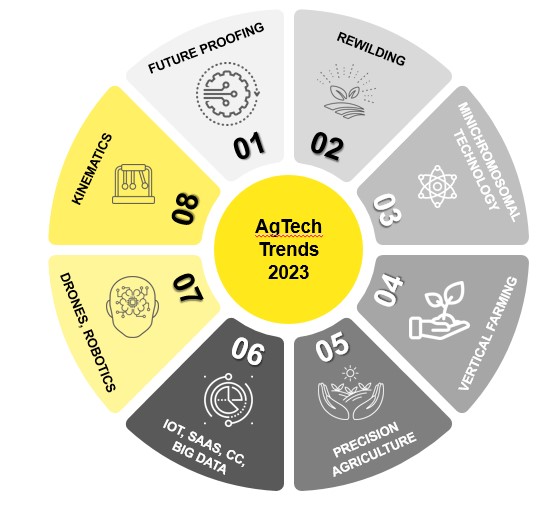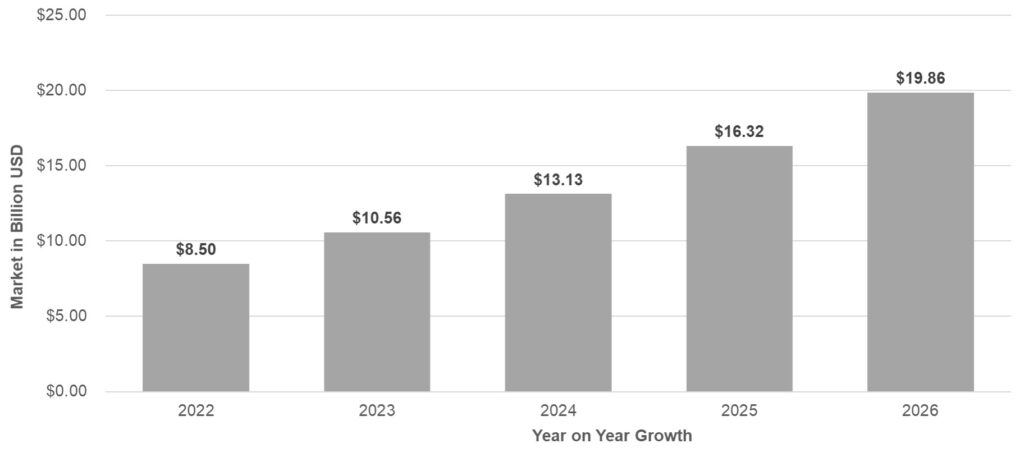The agriculture industry has evolved over the years, and calling it hi-tech is no longer an exaggeration. The advancement has exposed farming to different technologies, envisaging improved crops and food quality. Modern-day agricultural practices are based on a scientific approach that enables better production, less wastage, elimination of the harmful impacts of pesticides, and nutritious diets.

Figure 1: AgTech Trends 2023
Adapting various farming methodologies, rewilding, focusing on soil regeneration through microbes, significant data infusion, biofertilizers, automated farm equipment, raw material proofing, etc ., have transformed agriculture. Moreover, eco-friendliness and sustainability are two factors that the world is lurking in the future for food production—the blog glances at trends that can change the sector in 2023 and beyond.
Future-proofing in Agriculture
The objective is to find farmer-friendly technology. And that essentially means potent raw materials like seeds that can grow in any temperature or condition. Genome editing in plant breeding is one way of future-proofing. Also, pontificating supply chains that help the farm feed reach its destinations on time and incur no losses is important.
Many demographic, environmental, and health challenges affect food systems’ security, integrity, and future. The need to implement future-proofing strategies (to protect businesses and stakeholders) in a post-pandemic world has never been greater. Transparency, traceability, and transformation are essential to increasing trust across the food system and strengthening health and sustainability.
Rewilding in Agriculture
Approximately 40 percent of the world’s land belongs to agriculture. However, most of it is used for livestock grazing and fostering them. The wilderness area accounts for a mere quarter of the Earth’s surface. Thus, rewilding is essential for agriculture to establish the ecosystem and improve farm activities. Climate change mitigation and conservation of critical species, rivers, and other elements will be done in the future to enhance food production.
Minichromosomal Technology in Agriculture
It helps in several traits of plants through agricultural genetics. Synthetic chromosomes are added to the method in a sequential manner. They are beneficial agronomically, making crops drought tolerant and infusing better limitations for nitrogen use.
Vertical Farming for Agricultural Industry Reforms in 2023
Vertical Farming is portended as the future of agriculture vis-à-vis food production. It is being vouched as the greener alternative to traditional Farming in the US because they can grow more food per square foot than in conventional ways. Moreover, looking at the population expected to reach around 10 billion in 2050 globally, it’ll be important to grow 70 percent more food than the current levels worldwide, as per experts.

Interestingly, in the US alone, there are 2000 plus vertical farms. They produce lettuce, herbs, berries, and other crops.
Several industry stalwarts, such as Kalera, Bowery, Plenty, and others, operate throughout the year, regardless of weather conditions. Vertical farming is slated to grow at a CAGR of 25 percent, and the business will reach USD 9.7 billion globally by 2026.
Notably, retail giant Walmart also announced it would invest in Plenty, looking at its advantages and growing market.
Hydroponics in Agriculture
Physiologists have used the technology to use plant nutrients and scientists to research plants for more than a century. So, no soil is needed here. Instead, water is sufficient, and due to the rising temperature, farmers may be pushed to grow crops in water in the coming years. So, it makes up for the future.
Precision Agriculture Industry in Future
The year 2023 will see a rise in precision agriculture to ensure maximum protection of the environment using information technology. The concept follows the sustainability pathway, which aims at cost-effectiveness. It helps observe the number of fertilizers, water, and other natural elements crops and soil require for better yield.
Precision agriculture is data-driven and offers important information to farmers that aid them in identifying what crops to grow, the water needed, the ideal temperature, and the kind of pesticides and resources required while sowing.
Biofertilizers in Agriculture
Biofertilizers promote plant growth by strengthening the roots. The free-living bacteria enhance productivity and reduce the requirement for synthetic fertilizers. A study on farmers’ fields showed a 30% increase in yield and a 21% decrease in the production cost per kilogram. Also, given the demand for clean food, biofertilizers stand first in the line to reduce carbon footprint.
Increased Access to Soil Microbe Data for Farms
Microbial communities impact soil health immensely. They help enhance food production by supplying vital nutrients. Given the global movement to feed people globally, the focus will be on modulating microbial communities for plant growth even more in the coming days. Moreover, engineered microbial communities will help reduce the chemical fertilizers in the soil, supporting sustainability and weeding out carbon footprint.
Digital Twins: The Future in Agriculture
The use of digital twins has recently become common in agriculture corridors. The technology already enables the monitoring of livestock or animal health. Management decisions rely on field information reporting regarding fields and crop status.
The pre-emption of issues for farming machinery, like tractors, is getting help from remote monitoring via digital twins technology, high-fidelity modeling, and simulation. Real-time digital information is aiding the decoupling of physical flows and leveraging farming productivity and sustainability.
Farm Management Through Advanced Technology
Food security is critical following the bustling and bursting demography globally. Thus, adapting the outgrown information and communication technology, ICT, makes much sense. Infusion of the Internet of Things (IoT), SaaS (Software as a Service), blockchain technology, cloud, big data, etc. Moreover, intelligent farming will be more effective in 2023.
- Usage of IoT in farming: Agricultural inputs management, the panoply of sensor networks for optimizing irrigation, improving the maintenance and guidance. Interestingly, the use of farming sensors in agriculture will rise to 12 million in 2023.
- SaaS-based agriculture: Digitizing the agriculture sector through improved supply chains, managing farm finances, and excellence in operations is essential. SaaS helps establish the smart farming method. It infuses transparency, sustainability, and traceability into food chains worldwide.
- Big data in agriculture: It aids farmers in knowing and getting insights regarding rainfall, water cycle patterns, and other factors for optimizing crop growth. The configured data processes and finds areas that need improvement in farming.
- Cloud computing in the agriculture industry: The year 2023 will witness authorities putting excessive importance on cloud computing, which enables them to store data related to yields, crop type, land requirement, soil health, etc. This will aid in better farming outcomes through adaptive strategies in the future by countering issues faced by farmers.
- Computer vision in agriculture: It is pivotal in identifying product defects and issues. It considers factors like ripeness, color, size, weight, etc. Notably, they can reduce time-to-market and save time due to pairing with mechanical equipment.
- Drones in agriculture: Drone technology has just begun to fly in the industry. It harbors farmers in several ways, including avoiding chemical overuse, GEO fencing, crop spraying, soil and field analysis, livestock management, and crop and growth monitoring. Moreover, drone technology also helps in proper plantation, preparation for weather-related issues, and health check-ups of crops.
Robotics in the Agriculture Industry
The primary objective of robots in agriculture is profitability and efficiency. They work on proliferating environmental sustainability and specialization. The biggest reasons for robotic adaptability have risen following the lack of laborers, towering production costs, optimizing harvests, etc.
Robot Bees for Pollination
Robotic bees for pollination are changing the dynamics of farming. Deep learning is paving the way for the implementation of inventions on farms. It is the future for farmers looking to yield an advantage, given that the population of bees and other insects is declining rapidly.
Real-Time Kinematics in Agriculture Industry
RTK redefines the accuracy of maps, land surveys, clock correction, etc., for agriculture using the GNSS satellite data correction system. It is a technology sensor that assists broad-acre farmers with decreased overlapping, better land leveling, seamless strip-tilling, tracking, seeding, dripping, plantation, and spraying. Moreover, it helps yield greater while helping farming equipment like tractors move in an accurate direction using GPS. So, this technology will find many takers in 2023.
Automated Farm Equipment and Farming Vehicles
Driverless tractors are the future that will transform farming ways. 2023, the equipment will be more enthused and operated for precision in growing crops. Farmers can maneuver them using GPS navigation for several farm activities. That’ll save time and production costs and maintain hygiene.
Conclusion
The agriculture industry offers food on the table for every human. The body cannot function. So, every development fades away without the intake of proper nutrients. Also, given the rapid environmental changes, increasing population, limited resources, deteriorating nature, and declining soil microbes and forests, it is essential to entrust innovation and technologies that help agriculture boost and improve crops. Moreover, sustainability and eco-friendly farming are the needs of the time. So, incorporating trending technology can leverage production while simultaneously reducing costs. Also, for the acknowledgment of the technicalities in the field, research work, learning, and ideation aspects, the industry can contact us.